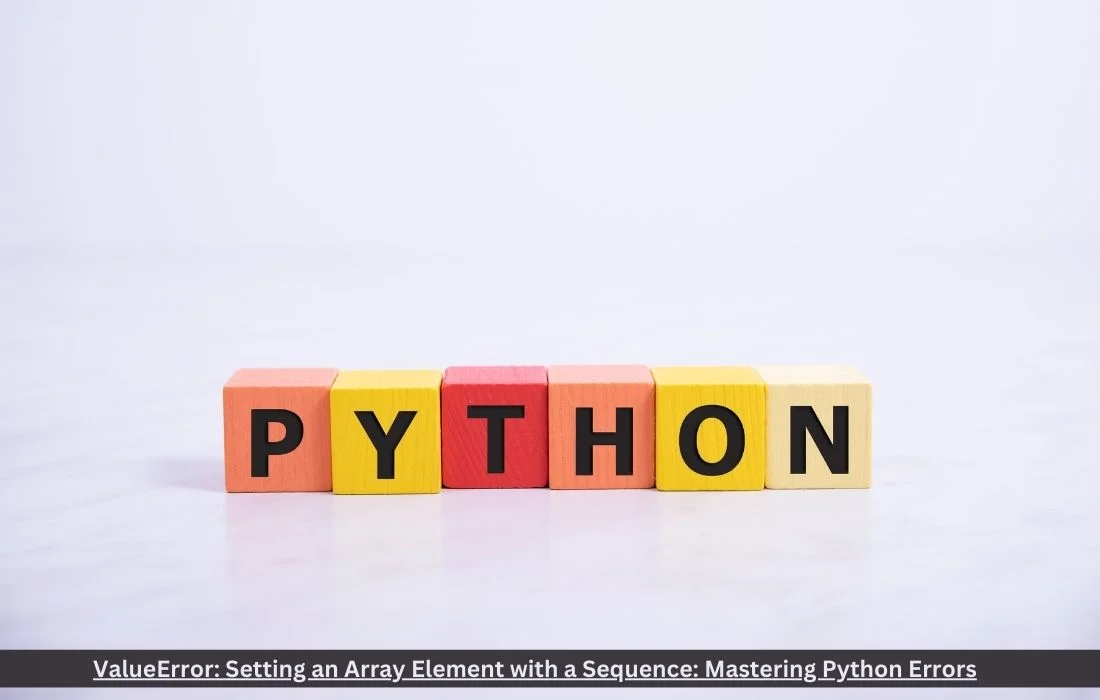Python is a powerful and flexible programming language, but it’s not without its quirks. One error you might encounter is the infamous ValueError: setting an array element with a sequence. If you’ve stumbled across this error while working with arrays or the NumPy library, you’re not alone. This issue can be frustrating, especially if you’re not sure what it means or how to resolve it. But don’t worry – in this article, we’ll break it down step by step, explain why this happens, and show you how to fix it.
What is ValueError in Python?
A ValueError in Python is an exception that is raised when a function receives an argument of the correct type but an inappropriate value. This error typically occurs when the function or operation is expecting a specific type of input but encounters something that doesn’t fit the expected format. These errors are common in Python, and one of their advantages is that they provide helpful hints to identify what went wrong.
Common Occurrences of ValueErrors
ValueErrors can happen in various contexts, such as when converting strings to integers, when trying to process incompatible types, or even when working with arrays. In fact, one of the most common causes of a ValueError occurs during operations with arrays in libraries like NumPy. Specifically, the error “setting an array element with a sequence” is a common ValueError, and it often confuses developers who are new to working with multi-dimensional arrays.
Importance of Understanding Error Messages
Error messages in Python are your friends, even if they seem cryptic at first. Understanding what the error is telling you is the first step toward solving it. When you encounter the ValueError: setting an array element with a sequence, it’s essential to know that this is related to arrays and how they handle data. Armed with this understanding, you can more easily pinpoint the issue in your code and apply the right fix.
Read Also: ‘Fatal: Refusing to Merge Unrelated Histories: How to Fix Step-by-Step Guide

What Causes the “Setting an Array Element with a Sequence” Error?
Let’s dig into the heart of this error. The ValueError: setting an array element with a sequence occurs when you try to assign a sequence (like a list or tuple) to a single element in an array. Arrays in Python (particularly NumPy arrays) are designed to hold elements of a specific type and shape. If you attempt to assign an object that doesn’t fit this structure, you’ll encounter this error.
Introduction to Arrays in Python
Arrays are data structures that store multiple values, often of the same type, in a single variable. In Python, NumPy is the most popular library for working with arrays because it provides a high-performance multidimensional array object and tools for working with these arrays.
The Role of NumPy in Array Manipulation
NumPy arrays are different from Python lists in that they are more strict about the data they store. You can think of them as matrices or grids of numbers. Unlike lists, arrays in NumPy are typed – which means that all elements must be of the same data type and shape. When NumPy expects a single number but gets a sequence (like a list or tuple), it throws a ValueError.
How Sequences Differ from Array Elements
An array element is a singular value (e.g., an integer or a float), whereas a sequence is a collection of values, such as a list or a tuple. If you try to insert a sequence into an array element that’s supposed to hold a single value, NumPy gets confused because it doesn’t know how to handle this sequence in a single slot.
Scenarios That Trigger the ValueError
Several scenarios can trigger the ValueError: setting an array element with a sequence. Here are a few common ones:
Scenario 1: Incorrect Shape of Data in NumPy Arrays
One common issue arises when you try to assign data of an incorrect shape to a NumPy array. For instance, if you have a 1D array and try to assign a 2D list or matrix to a single element, you will trigger this error.
Scenario 2: Assigning Lists or Tuples to Single Array Elements
Another frequent scenario involves assigning a list or tuple to a single position in an array, which expects a scalar value. For example, assigning [1, 2] to a slot that expects just one number (like 5) will raise this error.
Scenario 3: Incompatible Data Types in Arrays
NumPy arrays require consistent data types. If your array is of a numeric type, such as int32 or float64, and you attempt to assign a sequence that doesn’t match that type, NumPy will complain with this ValueError.
Scenario 4: Misuse of Multi-Dimensional Arrays
Using multi-dimensional arrays incorrectly, such as assigning values across mismatched dimensions or trying to reshape data improperly, can also lead to this error.
Read Also: Metro Stations Nearest to Jesus & Mary College

Step-by-Step Guide to Fixing the Error
Now that we know what causes the error, let’s go over some strategies to fix it.
Check the Shape and Dimensions of Your Array
The first step is to ensure that the shape and dimensions of your array match the data you’re trying to assign. If you have a 1D array, make sure the data you’re assigning is a single value, not a sequence.
Convert Sequences into NumPy Arrays Before Assignment
If you need to insert a sequence into an array, consider converting that sequence into a NumPy array first. By converting the sequence into the same data type, you can ensure compatibility.
Validate the Data Type Compatibility
Check that the data types match between the array and the value you’re assigning. If your array expects integers, ensure that you’re not trying to assign a float or a list of floats.
Use Proper Indexing for Multi-Dimensional Arrays
When working with multi-dimensional arrays, make sure you’re using the correct indexing. If you’re assigning values across dimensions, double-check that your indices and shapes align properly.
Detailed Examples of Fixes
Example 1: Fixing Shape Mismatch in NumPy Arrays
import numpy as np
arr = np.array([1, 2, 3])
# Incorrect: Trying to assign a list to an element
arr[0] = [4, 5] # Raises ValueError
# Correct: Assign a single value or reshape the array
arr[0] = 4
Example 2: Assigning Elements Correctly in Multi-Dimensional Arrays
arr_2d = np.array([[1, 2], [3, 4]])
# Incorrect: Trying to assign a list to a single element
arr_2d[0, 1] = [5, 6] # Raises ValueError
# Correct: Assign a single value or restructure the data
arr_2d[0, 1] = 5Example 3: Data Type Conversion Solutions
# Incorrect: Incompatible data types
arr = np.array([1, 2, 3])
arr[1] = [4.5] # Raises ValueError
# Correct: Convert the value before assignment
arr[1] = int(4.5)
Example 4: Correcting the Use of Lists in NumPy Arrays
# Correctly converting a list into a NumPy array
arr = np.array([1, 2, 3])
arr[1] = np.array([4])
How to Prevent the “Setting an Array Element with a Sequence” Error
Best Practices for Handling Arrays
One of the best ways to prevent this error is to always be aware of the shape and type of the data you’re working with. Before assigning values to arrays, double-check that the data is compatible with the array’s structure.
Working with Multi-Dimensional Arrays Effectively
When working with multi-dimensional arrays, ensure that you use appropriate indexing and slicing techniques. Always match the dimensions of the data you’re assigning to the structure of the array.
Debugging Tips for Identifying the Source of ValueError
To debug this error, try printing the shape of your arrays and the data types involved before the assignment. This will help you quickly identify where things go wrong.
Read Also: Traveling from Narayanguda Metro Station to Kacheguda Railway Station

Conclusion
The ValueError: setting an array element with a sequence is a common error that often trips up Python developers, especially those working with NumPy arrays. However, once you understand what causes this error and how to fix it, you’ll be able to handle array operations with ease. Just remember to keep an eye on your array shapes, data types, and dimensions, and always ensure that the data you’re assigning is compatible.
FAQs
Why am I getting a ValueError when working with NumPy arrays?
This usually happens when you try to assign a sequence (like a list or tuple) to an array element that expects a single value. Ensuring shape and type compatibility will prevent this error.
Can I assign a list or tuple to an array element in NumPy?
Typically, no. NumPy arrays expect scalar values, not sequences. To assign sequences, you’ll need to reshape your array or convert the sequence into a compatible format.
How do I convert a sequence to a format compatible with NumPy arrays?
You can convert a sequence like a list into a NumPy array using np.array() before assigning it to an array.
What is the difference between 1D and 2D arrays in NumPy?
A 1D array is a simple list of values, while a 2D array is essentially a matrix, with rows and columns. Each dimension adds a layer of complexity and requires specific indexing methods.
How do I debug other ValueErrors in Python?
You can debug ValueErrors by carefully reading the error message, checking the types and shapes of your data, and ensuring that the values passed into functions meet the expected criteria.
